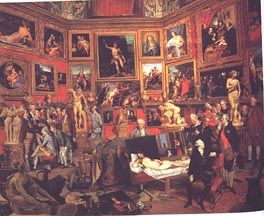
Art Home | ARTH Courses | ARTH 200 Assignments
The Gentlemanly Hang

Johann Zoffany, born in Germany but active in England after the 1760's, was commissioned by England's Queen Charlotte to create this pictorial account of the Uffizi, Florence's major museum. Zoffany set his painting in the octagonal room called the Tribuna. This room was constructed in the latter part of the 16th century to house the treasures of the Medici collection. The room is still one of the major focal points of the Uffizi collection. The official web-site of the Uffizi ( Galleria degli Uffizi) includes a QuickTime movie of the Tribuna as well as a number of the other major rooms. Zoffany sets into this room a group of English gentlemen who are admiring the masterpieces. Study of the painting has led to the identification of the gentlemen and the works of art on display:

The visit to the Uffizi collection represents for these gentlemen one of the major goals of the Grand Tour. During the 18th century, every young Englishman of good family was expected to take a journey of one to two years to the Continent frequently in the company of a tutor to be exposed to the great cultural monuments of France, the Netherlands, and especially Italy. The 18th century gentleman was meant to be a dilettante or connoisseur. As a symbol of status these members of the olded landed aristocracy and newly arrived commercial class became avid collectors of art, especially painting. The practice of collecting art helped to provide the upper ranks of English society a common class identity.
Carol Duncan in her book Civliizing Rituals includes a description of hanging a collection which closely corresponds to the hanging shown in the Zoffany painting:
Probably the most fashionable way of hanging a collection in the late eighteenth century was what might be called the connoisseur's or gentlemanly hang. This installation model was practiced internationally and corresponded rather precisely to the art education of European aristocrats. In the eighteenth and early nineteenth centuries, there was widespread agreement that cultivated men (and those few women who could claim such knowledge) that, aside from the sculpture of classical antiquity, the masters most worth collecting were sixteenth- and seventeenth -century Italian, Flemish, Dutch, and French. Men of taste and breeding, whatever their nationality, were expected to have learned key critical terms and concepts that distinguished particular artistic virtues of the most popular masters. Indeed, such knowledge was taken as a sign of aristocratic breeding, and in the course of the eighteenth century it became the fashion to hang collections, including royal collections in a way that highlighted the formal qualities of the various master-- that is, in a way that displayed one's knowledge of current critical fashions. A gentlemanly hang, be it in England, Italy, or France, might group together on one wall contrasting examples from opposing schools. For example, an Italian Venus or martyrdom on the right might be balanced by a Flemish Venus or martyrdom on the left, the better to show off their particular qualities of drawing, color, and composition.
The group of men in the center of the painting are arranged around the Venus of Urbino by Titian:
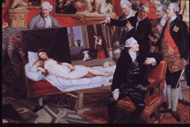
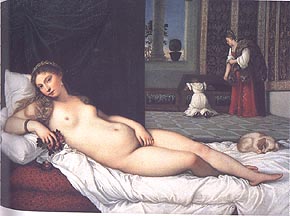
This Venetian work finished in 1538 played a major role in establishing the female nude as one of the central subject matters in Western painting since the Renaissance. In creating this work, Titian was reviving a tradition of the female nude that can be traced back to Late Classical Greek art of the 4th century B.C.E. The Greek origins of this tradition is exemplified by Zoffany's inclusion of a work still housed in the Tribuna, the Venus de Medici (or the Medici Aphrodite):
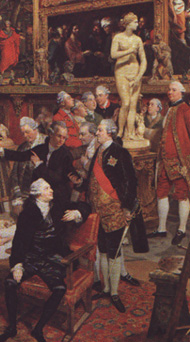
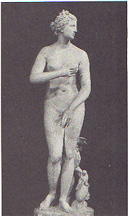
The walls are full of masterpieces:
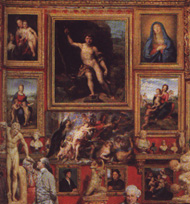
|
The work of the 16th century High Renaissance artist, Raphael appears prominently in the Zoffany painting, including:
The work of Raphael is juxtaposed to the work of the great 17th century Flemish artist, Peter Paul Rubens:

|

|
|
|
|
The 18th century connoisseur would have admired the fine drawing or disegno of Raphael's work in contrast to the colorism of the different works by Rubens. Zoffany has attempted to faithfully record these differences in styles in his reproductions of the great works. The 18th century connoisseur would have admired Zoffany for this virtuosity.
The room includes a good number of portraits. Along the wall are a series of Roman portrait busts, including a portrait of the Emperor Augustus Caesar. At the bottom of the back wall appears a portrait by Hans Holbein, who gained his fame in the sixteenth century painting portraits of Henry VIII, his wives, and members of his court:

|
|
|
Clearly the English gentlemen would have seen Southwell as a Tudor predecessor. To the left of this appears a portrait of Galileo:

|
In the upper right appears Rubens' painting of the Four Philosophers.. The inclusion of a classical bust in the upper right corner of this portrait of four 17th century philosophers reiterates the continuity of the Western intellectual tradition from Antiquity:

|
|
|
The English gentlemen would have clearly seen themselves as part of the same grand western tradition of the subjects of these portraits. It is interesting to note how Zoffany has cut off Pope Leo X in Raphael's famous portrait. Was this an intentional pro-Anglican and anti-Catholic reference?
A central message of the painting is how the English gentlemen are the rightful inheritors (and possessors) of this western tradition extending back to Antiquity through the Renaissance. The painting also valorizes the concept of the great artist and the masterpiece as a cultural fetish. As a review of the diagram of the painting makes clear, Zoffany draws the unmistakable parallel between the men as titled aristocrats and this collection of great masterpieces of Western Art. The gentlemen's assimilation of this tradition is manifested in their fashion where they themselves become objects of culture and works of art.
Questions for Consideration
The middle of the eighteenth century witnessed the development of aesthetics as a branch of philosophical thought. As defined by the Oxford English Dictionary, aesthetics is "the philosophy or theory of taste, or of the perception of the beautiful in nature and art." Consider the social and artistic ideological implications of aesthetics as illustrated in Zoffany's painting.
Zoffany's painting can be used as a illustration of the eighteenth century idea of the "masterpiece." Define the changes that have occurred in the idea of the masterpiece since its first uses during the later Middle Ages and the Renaissance.
Consider the gender implications of the painting with the central position of the nude female in Titian's Venus of Urbino.